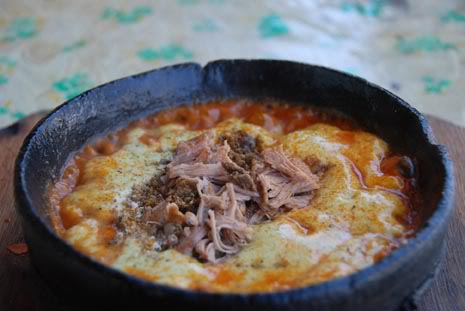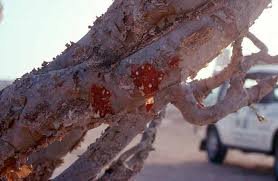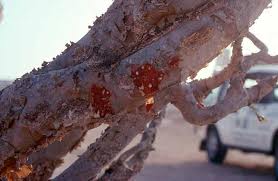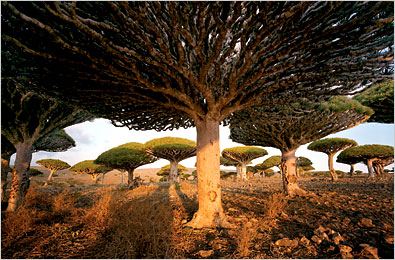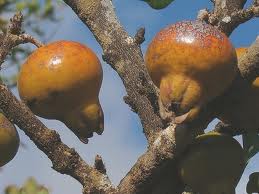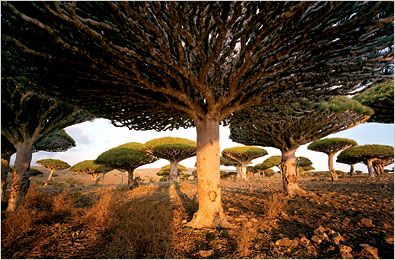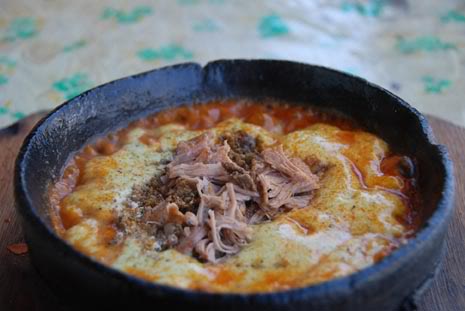The Wonder Land of Socotra, Yemen
“We have to be careful with the local communities,” Ahmed said. “We can’t just say, ‘Stop, stop, stop.’ They need to see a benefit first.” Our $10 guide, I understood, was one step in the education process.
After two hours we reached the peaks, a couple thousand feet up. I could see the coast below and the outline of Hadibu pressed against it. Ahmed handed me his binoculars and pointed a few yards away to a bird foraging on the ground: the Socotra bunting, with a rosy breast and black-and-white striped head. It is among the rarest of the island’s endemic species and is threatened by predation from feral, non-native cats. Birders come from around the world to catch sight of it. And here, Ahmed said, I’d seen it with no effort at all! I pictured men and women traveling thousands of miles to tick names off a life list and suddenly wasn’t sure whether it was absurd to keep such a list or shameful that I did not.
The forest of dragon’s blood trees, when we at last reached it, did not much resemble a forest, at least not the dense, dark sort associated with giant reptiles of myth. It was open and sparse, as though a light rain of broken umbrellas had fallen on the hillside. Recent years have seen a troubling decline in the tree’s numbers. Although many older examples are present on the island (they can grow for 300 years or more), the younger generation is all but absent, with saplings found growing only on cliff sides and in the most inaccessible highlands. The entire species may well be headed for extinction.
Scientists are unsure why. Grazing could be one cause; as development projects have brought a more steady supply of water to Bedouin villages, the herds of livestock have grown larger and more stable. A more important factor may be climate change: the island has seen a reduction in cloud and mist cover, which may affect the ability of dragon’s blood seeds to germinate.
After a lunch of wild oranges, we began the long hike out. I was tired and more than a little sun-dazed. My gaze slipped from the vista and became entranced by the rise and fall of the guide’s feet in front of me; I marveled at the upright, unlabored grace with which he moved, and the fact that he was barefoot. My thoughts coalesced around the fuzzy notion that all the dramatic landscapes I’d ever seen — Socotra, the Galapagos, Cape Breton, Yosemite Valley — in fact were one and the same and all visible here before my eyes. Then I would focus again on the guide’s bare feet and remember that I was not everywhere in the world but in fact somewhere like nowhere else. I invented a quiet little song:
I’m in Yemen, I’m in Yemen,
I see many men in Yemen.
I drifted along to the rhythm of this internal chant and soon expanded it into an elaborate mantra involving anemones, anonymity, metonymy and my anomie. When Ahmed suddenly addressed me in English, I was taken by surprise.
“Why do people want to travel to Socotra?”
I was stumped. His question was pragmatic, I’m sure, but in my fugue state it sounded existential. Why do people travel? What are tourists, and what do they — we — hope to take home? Pleasure in seeing something new, of course, but also pride in being among the privileged few to see it, and the self-assurance (however delusional) that our presence has not yet altered the very thing we’ve come to experience. How long can that spell go unbroken? Already, Paul Scholte told me, Socotra’s few tourists have one consistent complaint: they see too many tourists.
Even more than the flora and fauna, it seemed to me, the most fragile aspect of Socotra is its way of life. Here are a people whose own idea of travel mostly entails the pursuit of goats — a people, in effect, whose ancestors had ended their travels here centuries ago, then ventured no farther. The most endangered way of life nowadays is the one that goes, if not nowhere, then somewhere very slowly, and a traveler must go to the ends of the earth to see it.
I was tempted to ask our guide, if he could travel, what in the world he would want to see. But I refrained; the question would have meant nothing to him. When at last we reached our truck, I offered him a piece of the snack bar I’d been saving to celebrate. He picked at it and waved his hand, the international sign for “Thanks, but no thanks.” Kheapaak.
ESSENTIALS
BEFORE YOU GO: The main Web site of the Socotra Archipelago Conservation and Development Programme (www.socotraisland.org) has good background information. Visas are required for American travelers; visit www.cdc.gov for information on recommended vaccinations and medications. Although the U.S. State Department currently maintains a travel warning for Yemen, most experts agree that travelers need not have safety concerns about Socotra. Organizing travel to Socotra is challenging, so a travel agent can be very helpful
GETTING THERE AND GETTING AROUND: There are only two flights a week to the island, operated by Yemen Airways (www.yemenia.com); seats sell out well in advance. On the island, you need to hire a four-wheel-drive vehicle, as well as an English-speaking driver and guide. Expect to pay $250 to $350 for four days; be sure to negotiate in advance. These arrangements, as well as hotel reservations, can be made through the Socotra Ecotourism Society (ecosocotra@socotraisland.org).
HOTELS: The island’s few hotels are basic. Some have rooms with private bathrooms and flush toilets; all are inexpensive (about $10 a night). The Taj Socotra (no relation to the India-based chain) in Hadibu is simple and clean and has a popular outdoor restaurant; there’s also the newer Al Mohet and, outside of town near the airport, the Chalet Socotra. Camping is an ideal way to sleep, since the island’s main ecological sites are one or more hours’ drive away from Hadibu; you can arrange to rent gear on the island.
By ALAN BURDICK

